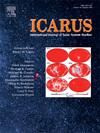High-precision permittivity estimation of the Lunar and Mars based on an enhanced approach considering GPR antenna positions
IF 2.5
2区 物理与天体物理
Q2 ASTRONOMY & ASTROPHYSICS
引用次数: 0
Abstract
The relative permittivity of a material measures its ability to store electric energy in an electric field. It is a significant parameter for characterizing the dielectric polarizability of a material. The hyperbolic fitting method is commonly used to estimate the relative permittivity of materials detected in the ground penetrating radar (GPR) area. Existing hyperbolic fitting methods often ignore the varying positions of transceiver antennas. This paper introduces an improved approach considering GPR antenna positions in three dimensions and it analyses the influencing factors which can result in estimation errors by gprMax simulations. When the buried object is deeper than 4 m, the general estimated error is less than 5 %. Additionally, the proposed method is also employed to both the high-frequency channel data of the Lunar Penetrating Radar (LPR) and Mars Rover Subsurface Penetrating Radar (RoSPR) according to their different transceiver antenna positions to estimate the dielectric constant at the Chang'E-4 (CE-4) and Tianwen-1 landing site, respectively. The calculated permittivity at the CE-4 landing site is and that at the Tianwen-1 landing site is . They are both slightly larger than the result obtained by the traditional hyperbolic fitting method. From their obtained dielectric constant maps, although CE-4 obtained a deeper distribution of permittivity, the distribution of dielectric constant at the CE-4 landing site is more homogeneous, indicating a more uniform lunar regolith. It suggests that, compared to the Moon, Mars experiences lower levels of space weathering at these landing sites due to the protection of the Martian atmosphere, which may cause heterogeneity of the shallow subsurface layer at the Tianwen-1 landing site.
求助全文
约1分钟内获得全文
求助全文
来源期刊

Icarus
地学天文-天文与天体物理
CiteScore
6.30
自引率
18.80%
发文量
356
审稿时长
2-4 weeks
期刊介绍:
Icarus is devoted to the publication of original contributions in the field of Solar System studies. Manuscripts reporting the results of new research - observational, experimental, or theoretical - concerning the astronomy, geology, meteorology, physics, chemistry, biology, and other scientific aspects of our Solar System or extrasolar systems are welcome. The journal generally does not publish papers devoted exclusively to the Sun, the Earth, celestial mechanics, meteoritics, or astrophysics. Icarus does not publish papers that provide "improved" versions of Bode''s law, or other numerical relations, without a sound physical basis. Icarus does not publish meeting announcements or general notices. Reviews, historical papers, and manuscripts describing spacecraft instrumentation may be considered, but only with prior approval of the editor. An entire issue of the journal is occasionally devoted to a single subject, usually arising from a conference on the same topic. The language of publication is English. American or British usage is accepted, but not a mixture of these.
 求助内容:
求助内容: 应助结果提醒方式:
应助结果提醒方式:


